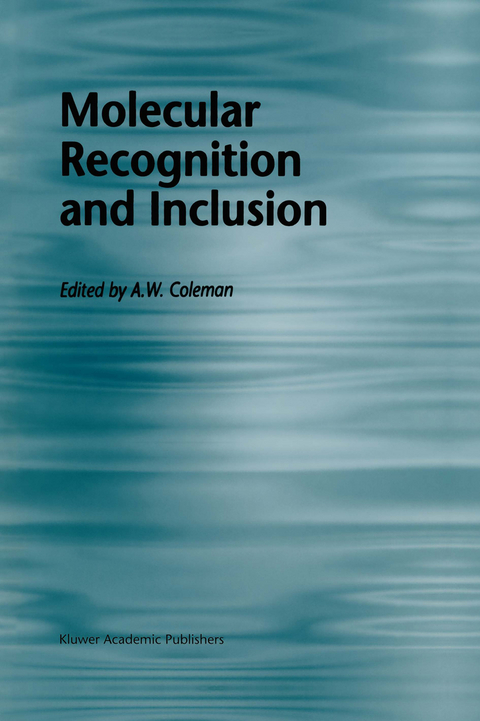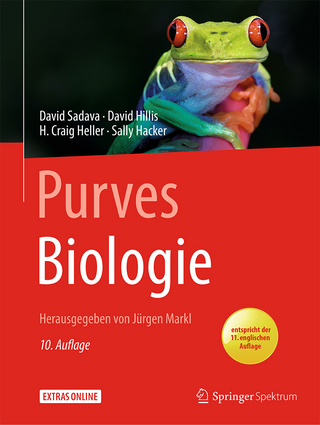
Molecular Recognition and Inclusion
Springer (Verlag)
978-94-010-6226-8 (ISBN)
Biological Importance of Glycosylation.- Hydration Interactions: Their Role in Recognition and Bioassembly Phenomena.- Tris(Macrocylcles) as Models for Transmembrane, Cation-Conducting Channels.- Construction of the Interfaces Possessing both Functionalities of Molecular Recognition and Electron Transfer.- Electrical Sieves for Molecule Recognition.- Supramolecular Complexation of Fullerenes and 1,2-Dicarbadodeca-Borane(12).- Molecular Switches Based on Molecular Inclusion.- Fluorescent Cyclodextrins as Chemosensors for Molecular Recognition.- Tetrathiafulvalenes in Macrocyclic and Sypramolecular Chemistry: Self Assembly with Tetrathiafulvalenes.- Anion Selective Recognition and Sensing by Novel Transition Metal Receptor Systems.- Macrocyclic Sugar Thioureas: Cyclooligosaccharides Mimicking Cyclopeptides.- Molecular Clefts derived from Kagan’s Ether. Synthesis and Solid State Inclusion Complexes of a Chiral Molecular Tweezer.- Molecular Tectonics: An Approach to Organic Networks.- New Macrocyclization Reaction based on Tris(2-aminoethyl)amine.- Signal Transmission by Artificial Receptors Embedded in Bilayer Membranes.- Inclusion Compounds: Kinetics and Selectivity.- Kinetics of Intercalation in Lamellar Hosts using Time-Resolved X-Ray Diffraction.- Control of Permeation of Ions Across Vesicles and Chemical Differentiation of Their Bilayer Membrane.- Molecular Recognition and Artificial Ion Channel with Amphiphilic Macrocycles.- Calix[4]-Bis-Crowns: From Nuclear Waste Treatment to Molecular Machines.- Tripodal Coordination Complexes as Scaffolds for Molecular Recognition and Catalysis.- Photochromc Molecular Recognition of Cyclodextrins Bearing Spiropyran Moiety for Organic Guests.- Interactions of Porphyrins with Cyclodextrins. Porphyrins as Probes for StudyingInclusion Phenomena.- Synthesis and Evaluation of New Ionoselective Materials.- Concave Reagents and Caralysts: From Lamps to Selectivity.- Order-Disorder Phenomena in Inclusion Compounds: A Solid State NMR Study.- One Class of Azocalixarene, Different Types of Assemblies in Solid State.- The Simple Synthesis of Chiral Diazocoronands Derived from D-Mannitol and L-Tartaric Acid.- Biomimetic Oxidation of Aromatic Aldehydes Catalyzed by a Bis(Coenzyme)-Cyclophane.- Some New Calix[4]Arene-Based Complexing Agents.- Development of Ruthenium Probes Designed to Bind Enantio- and Stereospecifically to DNA.- Affinity for Both 5-HT1a- and D1-Receptors and Anxiolytic Activity of N-(Arylpiperazinylalkyl)-Phthalimides.- Physico Chemical Studies of the Adsorption Process Between Animated Silica Wafers and Oligonucleotides.- How Can X-Ray Structures Be Helpful for Design of Ionophores for Ion-Selective Membrane Electrodes?.- The Synthesis and Conformational Analyses of Some Dibenzo[3n+2]Crown-n Ethers.- Calix[4]Resorcinarene Derivatives as Ionophores for Cations Studied in Polymeric (PVC) Membrane.- Synthesis of Isoflavone Derivatives of Crown Ethers.- The Synthesis of Some Coumestan and Related Chromogenic Derivatives of Crown Ethers, Part II.- The Association Constants of Macrocyclic Ether-Cation Interactions in Dioxane / Water Mixtures, Part II.- Binuclear Copper (II) Complexes of Cyclo-Bis Intercaland Receptors. Effect of the Ligand on the Crystal Structure and Complexation Properties.- Specific Interaction of ?-Casomorphin (Human) with Cu(II) Ion.- The Structure and Properties of the New Ligand for the 5-HT1A Receptors.- Phase Transitions of Cyclophosphazene Adducts Directly Followed by Solid-State NMR.- Molecular Recognition in Solid Inclusion Compounds of Novel Roof-ShapedDiol Hosts.- Success Rate in a Chiral Separation: Towards a Better Separation Machinery.- NMR Study of Per(3,6-Anhydro) ? Cyclodextrin as a Potential Agent for the Biological Decontamination of Lead as Evidenced by NMR Spectroscopy.- Thioureido ?-Cyclodextrins as Molecular Carriers for the Anticancer Drug Taxotère®.- Continuity and Discontinuity in the Thermodynamic Properties of Solid ?-Cyclodextrin Versus Hydration. A Comparative Study.- Phosphorylated Cavitands: Encapsulation of Hard Cationic Guests.- The Cation Complexation Properties of Per-3,6-Anhydro-? and ?-Cyclodextrins Studied by Thin Layer Chromatography and 1H NMR.- Caesium-Selective Imprinted Phenolic Resins.- Supramolecular Synthesis with Carboxyl-Substituted Secondary Dialkylammonium Salts and Macrocyclic Polyethers.- Cation Binding of Benzo Crown Ethers in Acetonitrile Using Fluorescence Spectroscopy, Part II.- Crystal Engineering with Novel Aminoborates. Hydrogen-Bonded Cyclic Motifs Containing Tetrahedral Boron and Nitrogen.- Novel Bis(Phenoxyalkyl)Sulfane Podands — Synthesis and Complex Formation with Thiophilic Metals Ions.- Design of Coordination Arrays as Potential Molecular Memory Units and Switches.- Synthesis of a Functionalized Chiral Molecular Tweezer.- Optimal Polymer Architecture for Adsorption at the Solid-Liquid Interface: Dendrimers Versus Linear Polymers.- Organizations of Two-Dimensional DNA-Mimetics at the Air-Water Interface.- Metal-Induced “Aggregation-Deaggregation” and “Colour Change” in Fullerene Derivatives.- Allosteric Regulation in the Catalytic Activity of Cyclodextrin Dimer as an Artificial Hydrolase.- Conformational Studies on Athryl(Alkylamino)-?-Cyclodextrin Complexes and Their Abilities as DNA Intercalators.- Host-Guest Complexation of PhosphorusContained Calixarenes with Aromatic Molecules in RP HPLC Conditions. The Stability Constants Determination.- Synthesis of Cyclodextrins Derivatives Carrying Bio-Recognisable Saccharide Antennae.- X-Ray and Atomic Force Microscopy Structures of Short Chain Amphiphilic Cyclodextrins.- Study of Inclusion of Cobalt(II) in Per-6-0-(Ter-Butyl Dimethylsilyl) ?-CD Using Pyrene as a Fluorescence Probe.- ?-Cyclodextrin Complexes of Polymers Containing Aromatic Groups.- Inclusion of Neutral Guests in a Self-Assembling Superstructure.- Recognition and Transport of Nucleoside Monophosphates with Synthetic Receptors.- Structure and Dynamics of Guest Molecules in Cyclophosphazene Inclusion Compounds.- Towards Rotaxane-Based Metal-Ion Sensors.- Microcalorimetric Studies of Ligand-Induced Vancomycin Dimerisation and Molecular Recognition.- Self-Assembled Hydrogen Bonded Dimers of Calix[4]Arenes.- Crystal Growth of Macrocycles in Gel.- Chiral Calixarenes Functionalized with Camphorsulfonyl Groups. Synthesis, Structure and Inclusion Properties.- Synthesis of Water Soluble Resorcinarenes Application in Nanofiltration-Complexation.- Crystal Engineering in Solid-State Metal Salt Complexes of Cyclodextrins.- Glycolipid Hydrolase Models. D, L-Stereorecognition of Amino Acids.- Anthracene-Crown Ethers: Synthesis and Complexation of Selected Cations.- Cyclo Bis-Intercaland Receptors: Structure of Two Interactive Inclusion Complexes. Stability of the Hydration Network Facing Two Different Substrates.- Zeolites as Catalysts: Porosity or Acidity? Alkylation of Benzene.- Quantification of Specific Immunological Reactions by Atomic Force Microscopy.- Transport Studies of Inorganic and Organic Cations Across Liquid Membranes Containing Mannich-Base Calix[4]Resorcinarenes.- Chiral RecognitionStudies of Amino Acids by Chiral Calix[4]Resorcinarenes in Langmuir Films.- Preorganized Macrocyclic Dicarboxylic Receptors. Synthesis, Inclusion Behaviour and Structural Study.- New Endo-Functional Cryptophanes as Selective Complexants.- In Search of New Tyrosinase Mimetics: Acyclic Polyaminic Ligands of Benzo[g]Phthalazine Able to Form Dinuclear Complexes with Cu(II).- Models Systems for Flavoenzyme Acitivity. Redox-Induced Modulation of Flavin-Receptor Hydrogen Bonding.- Selectivity in Thermodynamic Cyclisations of Cinchona Alkaloid Derivatives.- A New Bi-Functional Receptor for Acetylamino-Fluorene Modified Guanosine.- Macrocyclic Polyethers as Ditopic Co-Receptors for Dual-Centered Secondary Dialkylammonium Guests: From Double-Stranded to Single-Stranded Pseudorotaxanes.- Synthesis of a 20-Crown-6 from D-Glucose and First Study of Its Alkali Metal Cations Affinity by MALDI-FTMS.- 2H NMR Investigations of the Cyclohexane/Tri-o-Thymotide Inclusion Compound.- Inclusion Complexes of Siliconhydrofluoric Acid Transformation Products with the Crown Ethers.- Study of the Interaction of the Host: Guest Type Between SnF2:?-Cyclodextrin.- 13C CP/MAS Studies of Rhodium (II) 3-Fluorobenzoate and Their Inclusion Compound in ?-Cyclodextrin.- Anion Recognition Using Boronate-Ureas.- Synthesis and Self-Organisation of New Cyclodextrin Amphiphile.- Molecular Recognition of Anionic Species: Hydrogen-Bonding Properties of Sulfate and Thiocyanate.- Synthesis and Characterization of Na+ and Ba2+ Complexes with Some Lipophilic Diaza-18-Crown-6 Derivatives.- The Effect of Macrocycles on the Reaction Rate. Part V. The Effect of [18]Crown-6 on the Aromatic Nucleophilic Substitution Reactions in Dioxane-Water Solutions.- Stereocontrol and Rate Enhancement of a Diels Alder Reaction Withinan Unsymmetrical Porphyrin Host.- Preorganization of Linear Polyamines in the Solid State.- Vibrational Spectroscopic Studies on the Inclusion Complexation by ?-Cyclodextrin.
| Zusatzinfo | XV, 546 p. |
|---|---|
| Verlagsort | Dordrecht |
| Sprache | englisch |
| Maße | 160 x 240 mm |
| Themenwelt | Naturwissenschaften ► Biologie |
| Naturwissenschaften ► Chemie | |
| Naturwissenschaften ► Physik / Astronomie | |
| ISBN-10 | 94-010-6226-9 / 9401062269 |
| ISBN-13 | 978-94-010-6226-8 / 9789401062268 |
| Zustand | Neuware |
| Haben Sie eine Frage zum Produkt? |
aus dem Bereich


